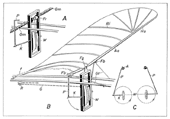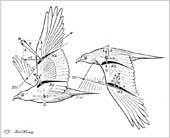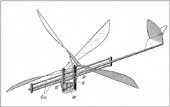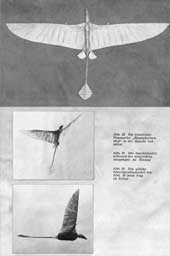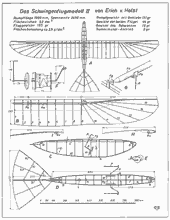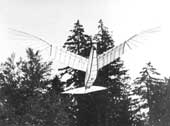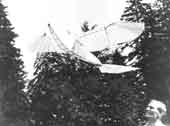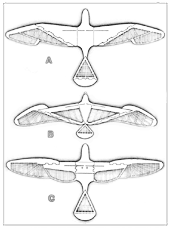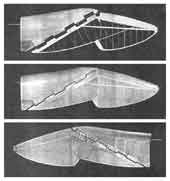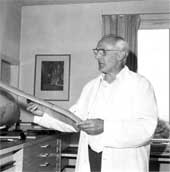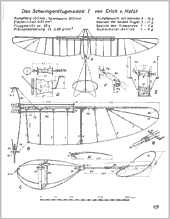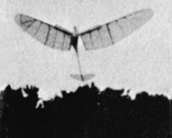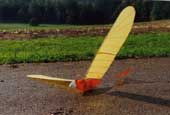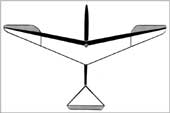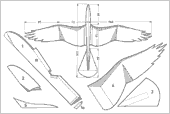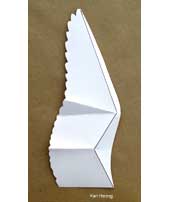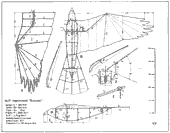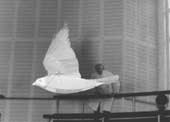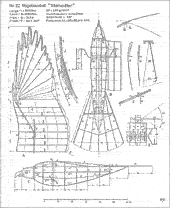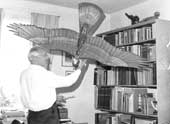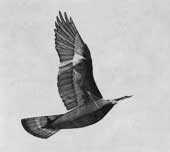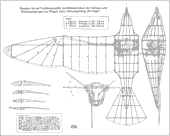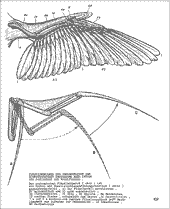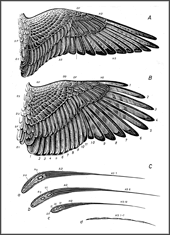Erich von Holst and Karl Herzog
1. Prof. Dr. Erich von Holst
-
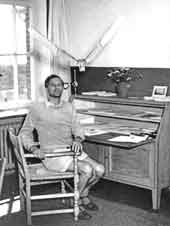
- Erich von Holst
with his model
Erich v. Holst (1908-1962) researched on biological and aerodynamic problems of animal flight. In interplay between creative flying models, many experiments and consequentially thoughts he reached new perceptions about the flapping flight. Thereby a main focus of his work was on the determination of force distributions along the wing on up- and downstroke.
These conceptions of the aerodynamics and flight mechanics of flapping flight were the basis for his new wing designs with the corresponding drive mechanisms. Each of his flapping wing models was equipped with an especially for this designed rubber motor.
Erich von Holst explains the propulsion or thrust generation of birds flying with a great rate of advance by means of a lift shifting along the wing. Correspondingly he wrote in his paper About »artificial birds« as a means of studying the flight of bird (1943, in German, PDF 3.2 MB):
-

- Basic principle of lift and thrust generation in the flight of birds
- This is the original image with unequal cycle times.
An image with equal cycle times, is shown in Flying with approximately constant lift
It would be the ideal situation for the bird when during the downstroke of the wing the arm section and during the upstroke the hand section was missing. You can make it plausible if you imagine, the wing area would be reduced and could slip along the longitudinal axis of the wing. It would then be shifted to the wing tip on the top of the stroke and to the wing root on the bottom point. In this way, seen over a whole flapping period, while maintaining the normal force Q (or the lift) the thrust S gets larger than the backward directed force R. This ingenious trick of nature solves the mystery of bird flight.
The fact that one can even recover the lost energy associated with the rearward directed drive R and use it again (see The principle of flight / Operating principle) was not yet known at that time.
This view of the flapping flight by E. v. Holst - with his combination of theory and practice - has strongly influenced the development of my EV ornithopter models shown here.
-
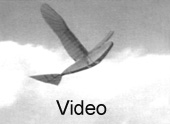
- 720 x 576 mp4 (3.6 MB)
- 480 x 360 mp4 (2.1 MB)
- 320 x 240 mp4 (1.6MB)
There is film footage with sequences in slow motion of some flapping wing models
by E. v. Holst in the 1940's. It can be seen the large model Swan
and the model of a Brimstone Butterfly in flight. Furthermore there is shown his
Thrust-Wing
with its rotating flapping wings
- an inspiration from the flight of Dragonfly. The video is an excerpt from the
film Wings Over the World
.
1.1 Publications by Erich von Holst
Erich v. Holst, Tierflug und Modellflug.
Luftfahrt und Schule, 6. Jahrgang, Dez. 1940, Heft 3, Seite 24-26 Berlin-Charlottenburg
2
PDF
(in German)
1.6 MB
Animated pictures of a slow motion film from this article. One can see the rise off ground of a rubber-powered ornithopter and particularly the changing of the angle of incidence at the wing root recommended by Erich von Holst.
Erich v. Holst and Dietrich Küchemann,
Biologische und aerodynamische Probleme des Tierflugs. Naturwissenschaften
13. Juni 1941, Volume 29, Issue 24-25, pp 348-362 Springer-Verlag, Berlin
or
Holst, E. von and Küchemann
Biological and Aerodynamical Problems of Animal Flight. Royal Aeronautical
Society Journal, vol. 46
PDF
(in German)
2.2 MB
Erich v Holst, Gesammelte Abhandlungen
© R. Piper & Co. Verlag, Munich (Germany) 1970
An essay from it:
look at
![]() literature
literature
Erich von Holst. About »artificial birds« as a means of studying
the flight of birds (in German)
Journal für Ornithologie issue 91, page 406-44 7 (1943)
3.2 MB
1.2 Crank drive for generating the stroke and twisting movement of a flapping wing
The rubber powered crank drive with a filament gear, developed by Prof. E. v. Holst, generates the stroke and twist motions of the wing at the same time. Thereto, the linkage coming from the crank pin is rotable mounted only in stroke direction at the spar of the flapping wing, but in turning direction torsion-resistant.
Thereby, the up and down motion of the crank pin is used to drive the stroke motion
of the spar. At the same time the back and forward motion of the crank pin is
used for turning the spar. Furthermore, the spar is torsion-resistant connected
with only one of the outer ribs (Ri). Thus, the crank mechanism actively effects
the twisting of the flapping wing. Stroke and turning motion of the wing spars
are phase-delayed by 90 degrees. The non-tensioned thread f
at the rear
end of the wing root rib allows the wing root to turn during up- and downstroke.
You can find descriptions of several rubber motors in the articles by Karl Herzog (in German) of March und April 1963 below.
2. Karl Herzog
A great admirer of E. v. Holst was the academic painter and university painter Karl Herzog from Tübingen. In general he has done a very great service to the documentation of Erich von Holst's models. Mr. Herzog also has drawn and built his own bird models according to the models of E. v. Holst and has been busy intensively with the flight of birds. Karl Herzog has been my pen friend over many years.
2.1 Flapping wing flight in nature and science
In the year 1963/64 the modelling magazine Mechanikus
published a series
of articles by Karl Herzog with the title Der Schwingenflug in der Natur und
in der Technik
Among other things he drew and described there how the models by E. v. Holst can be built. Below, these articles are available separately in PDF-format (all in German). But there is also a compilation (PDF 9.0 MB) of all articles.
Of these series there is also an old abbreviated English version (PDF 2.4 MB) with partly different pictures. It was also translated in the Netherlands (PDF 1.2 MB) by Louis van Telgen.
Efforts in the history of flying
PDF1.5 MB
Biophysics of the bird flight
PDF1.4 MB
Flapping wing models by E. v. Holst
PDF1.9 MB
The artificial Rhamphorhynchus in flight
by E. v. Holst. The pterosaur has been powered by a rubber motor. Together
with the clever filament gear the drive is pictured in the Gesammelte Abhandlungen,
Band II
by E. v. Holst (p. 116 and 136). Please look at ![]() literature
literature
Please also look at the bottom Wing-function of flying saurian
Flapping wing models by E. v. Holst
PDF0.7 MB
1963 April
This is the plan of the flapping wing model Swan
by E. v. Holst, drawn
by K. Herzog.
There is also a video of the Swan
(look above).
This edition consists the specification of the model Swan
and the plan of the model Buzzard
.
5. Sequence
PDF1.0 MB
1963 October
Here is a design study of flapping wings by Karl Herzog. At the version A and B the axis of the hand wing runs obliquely in relation to the flight direction, like on birds. Other designers of flapping wings mostly aligned it parallel to the longitudinal axis of the wing (like version C).
6. Sequence
PDF0.7 MB
7. Sequence
PDF0.4 MB
Animated pictures from the Buzzard
of an old slow motion film (by Erich von Holst: Über künstliche
Vögel
als Mittel zum Studium des Vogelflugs. Journal für Ornithologie,
Band 91, 1943).
The animation shows a climb flight of the artificial bird of about 30 deg and a flapping period of 2.5 per second. There is to seen the small turning of the wing root and the wing twisting.
Buzzard
with electric drive
The model has had a crank drive mechanism according to the crank by E. v.
Holst and the relevant drawings by Karl Herzog (see above).
8. Sequence
PDF0.7 MB
Pathways to the technical flapping flight
PDF0.7 MB
Today, the Aue-Verlag, Möckmühl, Germany, owns the copyright of this series by Karl Herzog. Text and drawings may not be published elsewhere.
2.2 Further works by Karl Herzog
Later Karl Herzog has written the ![]() book
book Anatomie und Flugbiologie
der Vögel
, published 1968. At the pages 136 to 168 it contains
the chapter Demonstration of the animal flight on the basis of bird models
and flapping flight gadgets
. Regrettably the book is not available today.
2.3 Deutsches Museum
Herzog has also played an important part in the design of the permanent exhibition
Flight in nature
in the Deutsches Museum in Munich.
-
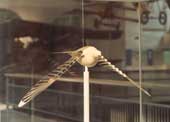
- Demo-model runing (800 KB)
Show-case in the Deutsches Museum
Demonstration model with an active arm wing twisting by a pitching motion of the spare, built 1985 by suggestion and plans of Karl Herzog.
Plan of the functional model
which is shown in the show case, to show the stroke- and twisting motions of the wings during the flapping flight of birds.
3. Wing-function of flying saurian (pterosauria)
Karl Herzog has found that in birds in the state of a stretched wing the tendons
and bands of the wing are tensioned in such a way, that the wing twist is
set for gliding or sailing (please look at his book ![]() Anatomie und Flugbiologie der Vögel,
published 1968, page 43). Muscle force for setting the correct wing twist,
therefore, is not necessary, but only for stretching of the. It is caused
in particular by muscles of the inner wing. This was probably also the case
with flysaurs.
Anatomie und Flugbiologie der Vögel,
published 1968, page 43). Muscle force for setting the correct wing twist,
therefore, is not necessary, but only for stretching of the. It is caused
in particular by muscles of the inner wing. This was probably also the case
with flysaurs.
Birds stabilized the angle of attack along the entire wing with feathers that are torsion resistant fixed to the bones. For this purpose, predators had in particular the flight finger at their disposition. They also used it to control the tensile stress of the wing membrane. For this they probably had a similar stretching and twisting mechanism as birds do today.
According to this, in pterosaurs with an outstretched wing and without approaching flow, the wing tips were bent relatively far downwards on the outside and the angle of incidence along the entire span was large. When inflowing with glide velocity, suitable profile cambers and the appropriate angles of attack then aeroelastically have been adjusted by itself with the aid of the actinofibrils. At the same time, the lift raised the wing up to the position of gliding flight.
Based on this, the correct profile camber, the correct angle of attack and a suitable wing shape have been aeroelastically adjusted also during downstroke, with its outward shifted lift.
Pterodactyl
(short-tailed pterosaurs) during wing upstroke
The picture is adapted from the flight image
of a swan from ahead, during wing upstroke.
In order to use this automatism also during upstroke, the trailing edge of the wing membrane must always be tightly tensioned. Only in this way can be developed sufficient lift, especially in the inner wing (see picture). A backward bending of the outer dinosaur wing, as in birds, is therefore very unlikely. On the other hand, a downward bending would have a positive effect on the pulling direction of the trailing edge of the wing membrane. In addition, in order to support the shifting of lift or thrust generation, also for pterosaurs a nodding motion of the body comes into consideration (please look at chapter 6., Lift during wing upstroke, version 10.1, PDF 1.0 MB). This increases the angle of attack on the inner wing during upstroke.
It is certainly very demanding to build an ornithopter with such a flight technique
(see replica of a pterosaurs - a Quetzalcoatlus Northropi, by ![]() Paul MacCready).
Paul MacCready).
4. Related Links
- Studiengemeinschaft Wort und Wissen e.V.
Dino-Federvieh - Zum Ursprung von Vogelfeder und Vogelflug
written by Reinhard Junker (2017):
https://www.wort-und-wissen.org/artikel/dino-federvieh-zum-ursprung-von-vogelfeder-und-vogelflug/
and additional online material - PDF
Chapter 4. Modelle zur Entstehung des Vogelflugs
http://www.si-journal.de/jg25/heft1/feder-und-flug.pdf


